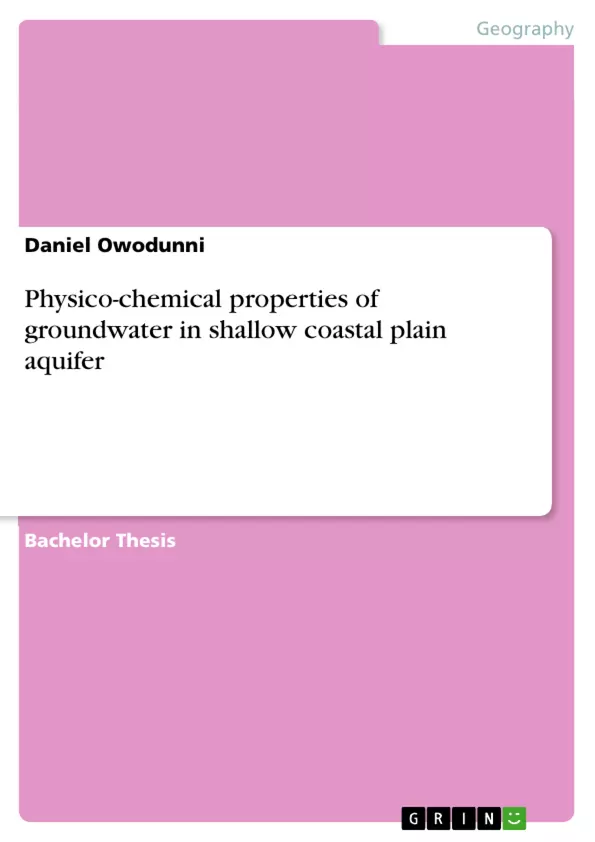The inhabitants of Abesan Area, Southwestern Nigeria depend on groundwater for their daily domestic consumption and irrigation purposes. Thirty groundwater samples were collected from selected shallow hand-dug wells hosted in the Coastal Plain Sands aquifer for groundwater quality assessment.
The samples collected were analyzed for pH, Total Dissolved Solids (TDS), Electrical Conductivity (EC), and dissolved ions (Na+, K+, Ca2+, Mg2+, HCO3-, SO42-, Cl-, and NO3-) for water quality assessment as well as their suitability for irrigation.
Results of chemical analyses of groundwater showed that the relative concentration of cations and anions are in the order of Ca2+>Mg2+>Na+>K+ and HCO3>Cl−->SO42-−>NO3−, respectively. The plots in all the locations indicated that the bicarbonate ions dominate other anions while calcium ions dominate other cations. The predominance of bicarbonate ions suggests a continental origin for the groundwater of the study area. The chemical quality of the water samples is within the acceptable limit of the World Health Organization (WHO) standards for drinking, domestic, and irrigation purposes in all the wells studied.
Five water irrigation quality parameters were employed for this study which include the Magnesium Adsorption Ratio (MAR), Sodium Absorption Ratio (SAR), Soluble Sodium Percentage (SSP), Residual Sodium Carbonates (RSC), and Kelly's Ratio. Based on the irrigation parameters calculated, all the samples were classified as suitable for agriculture purposes. Most of the sampled groundwater in the Abesan Area from this study is found suitable for domestic and irrigation purposes.
Inhaltsverzeichnis (Table of Contents)
- Abstract
- CHAPTER ONE
- 1.0 INTRODUCTION
- 1.1 General Statement
- 1.2 Aim and Objectives
- 1.3 Study Area
- 1.3.1 Location of Study Area
- 1.3.2 Climate and Vegetation
- 1.3.3 Topography
- 1.3.4 Local Geology of Abesan Area
- 1.3.4.1 Regional Geological Setting
- 1.3.4.1.1 Stratigraphy of Dahomey
- 1.3.1.1.1 Abeokuta Group
- 1.3.1.1.1.1 Ise Formation
- 1.3.1.1.1.2 Afowo Formation
- 1.3.1.1.1.3 Araromi Formation
- 1.3.1.1.1.4 Ewekoro Formation
- 1.3.1.1.1.5 Akinbo Shale
- 1.3.1.1.1.6 Oshosun and Ilaro Formations
- 1.3.2 Hydrogeology of the study Area
- 1.4 Common Chemical Constituents in Groundwater
- 1.5 Literature Review
- CHAPTER TWO
- 2.0 MATERIALS AND METHODS
- 2.1 Materials
- 2.1.1 Field Materials and Equipment
- 2.1.2 Laboratory Materials and Equipment
- 2.2 RESEARCH METHODOLOGY
- 2.2.1 Desk Study
- 2.2.2 Well Selection
- 2.2.3 Water Table Measurement
- 2.2.4 Field Measurement
- 2.2.5 Field Analysis
- 2.3 Method of Chemical / Laboratory Analysis
- 2.3.1 Titrimetric and Turbidimetric Method
- 2.3.1.1 Determination of Concentration Chloride (Mohr's method)
- 2.3.1.2 Determination of Concentration of Bicarbonate
- 2.3.2 Ultraviolet / Visible Spectrophotometric Method
- 2.3.2.1 Determination of Concentration of Sulphate (Turbidimetric Method)
- 2.3.2.2 Determination of Concentration of Nitrate (Sodium Salicylate Method)
- 2.3.3 Atomic Absorption Spectrophotometric Method
- 2.4 Irrigation Water Quality
- CHAPTER THREE
- 3.0 DATA PRESENTATION AND INTERPRETATION
- 3.1 Data Presentation
- 3.2 Physicochemical Data Interpretation
- 3.2.1 Hydrogen Ion Concentration (pH)
- 3.1.2 Electrical Conductivity
- 3.1.3 Total Dissolved Solids (TDS)
- 3.2 Geochemical Data Constituents Interpretation
- 3.2.1 Major Cations
- 3.2.2 Major Anions
- 3.3 Irrigation Parameters
- 3.3.1 Sodium Hazard
- 3.3.2 Bicarbonate Hazard
- 3.3.3 Magnesium Hazard
- 3.3.4 Kelly's Ratio
- CHAPTER FOUR
- 4.0 DISCUSSION AND CONCLUSION
- 4.1 Discussion
- 4.1.1 Physical Chemistry
- 4.1.2 Groundwater Chemistry
- 4.1.3 Irrigation Purposes
- Reference
- Physico-chemical properties of groundwater in the Abesan Area
- Groundwater quality assessment for domestic and irrigation purposes
- Assessment of the suitability of Coastal Plain Sands aquifer for groundwater resources
- Investigation of major chemical constituents and their impact on water quality
- Analysis of irrigation parameters for agricultural feasibility
- CHAPTER ONE provides an introduction to the study area, outlining its location, climate, vegetation, topography, and local geology. It delves into the regional geological setting, highlighting the stratigraphy of the Dahomey Basin and the specific formations within the Abeokuta Group. It concludes with a discussion on the hydrogeology of the study area and the common chemical constituents found in groundwater.
- CHAPTER TWO details the materials and methods employed in the research. This includes a description of the field and laboratory equipment used, the research methodology, and the specific analytical techniques employed to determine the concentration of various chemical constituents in the collected groundwater samples.
- CHAPTER THREE presents and interprets the data gathered from the physico-chemical analysis of the groundwater samples. It includes an analysis of the pH, electrical conductivity, total dissolved solids, and the major cations and anions found in the samples. This chapter further explores the implications of these findings for irrigation purposes by examining different water quality parameters such as sodium hazard, bicarbonate hazard, magnesium hazard, and Kelly's Ratio.
Zielsetzung und Themenschwerpunkte (Objectives and Key Themes)
This thesis focuses on the evaluation of groundwater quality in the Abesan Area of Lagos, Southwestern Nigeria, for its suitability for domestic and irrigation purposes. This research aims to provide crucial information about the physico-chemical characteristics of groundwater in the Coastal Plain Sands aquifer, particularly in relation to its suitability for various human needs. The research delves into the hydrogeological and geological features of the study area, examines the major chemical constituents in groundwater, and analyzes the data collected to assess water quality parameters.
Zusammenfassung der Kapitel (Chapter Summaries)
Schlüsselwörter (Keywords)
This thesis utilizes the following keywords to explore the intricate relationship between groundwater quality and its suitability for various uses, focusing on a specific geographical area in Southwestern Nigeria. This research utilizes key concepts and terminology from the fields of hydrogeology, geochemistry, and irrigation science to evaluate the physico-chemical properties of groundwater in a shallow coastal plain aquifer. This includes terms such as Coastal Plain Sands aquifer, groundwater quality assessment, physico-chemical properties, major cations and anions, irrigation water quality parameters, Sodium Absorption Ratio (SAR), Residual Sodium Carbonates (RSC), Kelly's Ratio, and suitability for domestic and irrigation purposes.
- Quote paper
- Daniel Owodunni (Author), 2019, Physico-chemical properties of groundwater in shallow coastal plain aquifer, Munich, GRIN Verlag, https://www.grin.com/document/1403059



